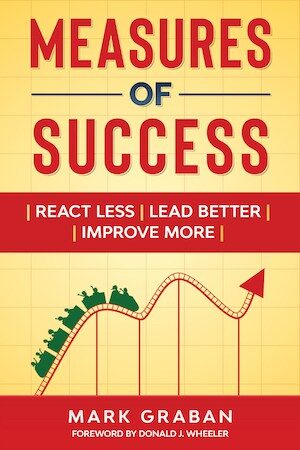
I realize there's a lot of serious stuff taking place in the world… and that's weighing on my mind a ton, which is one reason why I haven't been blogging quite as much recently.
But, if you'll forgive the indulgence, I'm going to share a few reflections about the year's anniversary (or birthday?) of the paperback release of my book Measures of Success: React Less, Lead Better, Improve More (the Kindle version and other eBook versions were available about six months earlier).
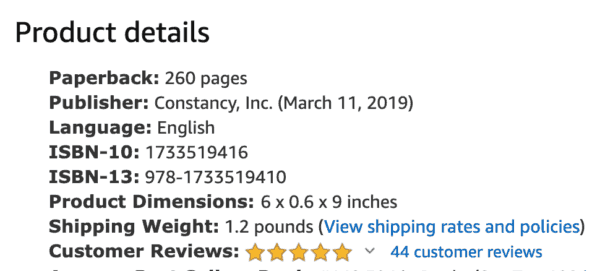
I'm glad that the reviews and ratings have been positive.
I was just happy that anybody was willing to buy the book. I wrote it as a labor of love — to help share something that I thought was an important topic and an underappreciated method. I didn't write the book based on any sort of market research. Like many authors, I wrote it because I wanted to… because I felt like I had to. I'm glad it has sold (and sales have been about on par with Lean Hospitals, although the 3rd edition of that book has been on the market longer).
Putting it to Use
Sales are one thing. Again, I'm happy to see positive reviews and ratings, More importantly, though, I'm thrilled that people have put the book to use. They've applied “Process Behavior Charts” in their organizations — either in limited or widespread use.
In one example, I was brought to a health system to teach a short workshop at a quarterly all-leader event. The CEO encouraged everyone to start using this method for their metrics. Three months later, they reconvened and each leader was asked to bring at least one of their PBCs to post so they could share and learn from each other.

Self Publishing
Many people have asked (especially fellow authors) if I'm happy with my decision to self publish this book.
Yes.
I still feel like it was the right decision to self publish. I don't regret it for one minute. Yes, I had to pay upfront costs to hire contractors to do editing, typesetting, cover design, etc. but thankfully I was able to do that.
The benefits of self publishing include:
- Faster time to market
- Complete creative control (title, cover, layout, etc.)
- Complete control over pricing
Measures of Success is more expensive than it might have been, because it's a full-color book. The price is certainly lower than it would have been through my previous publisher. I think the economics work out better that way.
eBook then Paperback
The biggest cost was the investment in the design of the paperback book interior and pages (thanks to 1106design for their excellent work and customer service).
Part of my strategy to initially publish the eBook version (through Amazon, Apple, and Google — oh, and LeanPub) was to test the market. If nobody (or very few people) had bought the eBook, I probably would have skipped doing a print book altogether. But, thankfully I had eBook sales (and sustained sales) — better yet, I had people asking me when the print edition would be made available.
So, I went ahead and made that investment.
Later, I was able to add a hardcover version, for those who prefer that. It's about $25 more than the paperback, but it's more durable for those who want to share it or keep it in a company library.
Printing — Who Prints Them?
One choice that I had to make as a publisher was “who would print the books?”
From my research and understanding of the situation, I had two choices — Amazon and IngramSpark. There were pros and cons.
If I let Amazon print the books, the cost is 2x the price of IngramSpark (it's about $19 vs. $9). This is, again, for a full-color book. The price differential is not as great for black-and-white books.
I got sample books printed by both and the quality of the paper, the cover, and the printing seemed to be very much the same.
I had read that if I let Amazon print the books, that was the “path of least resistance” into the global Amazon supply chain. I do have buyers / readers from countries all around the world (thank you!). The book would be available for shipping more quickly than if I used IngramSpark as the printer and distributor. And, I had read that books printed by Amazon never showed as “out of stock.”
Again, IngramSpark was cheaper, but I'd be dependent on Amazon ordering books from IngramSpark and then maintaining inventory at various locations. There would be a risk that the book would sometimes show as out of stock, which might hurt sales.
I chose the path of least resistance. But, here's the funny thing… from a retail price of $39.95 (that I choose), Amazon has discounted the book by various amounts — and it's been $30 for a long time now.
That $10 reduction is taken out of Amazon's margin. So, they charge more for printing, but then give it back by discounting the book. So, it's a wash to me, as long as Amazon keeps discounting it.
When I created the hardcover version through IngramSpark, I thought I would sell just a few direct order copies and maybe a bulk order or two. Well, Amazon decided to start selling the hardcover, so they choose how many order from IngramSpark (and they also choose to discount it about $5).
By the way, if retailers other than Amazon decide to sell the book, they would order paperbacks or hardcovers from IngramSpark (with them serving, again, as the printer and distributor).
A Process Behavior Chart for Book Sales
I've shared this in various webinars (particularly this one), but I, of course, had a PBC for book sales (wouldn't you be disappointed in me if I didn't?).
This is the chart for weekly sales going through Week 37 of last year. I stopped updated the chart because I got busy with other things and I wasn't really learning anything new from the chart over time as sales stayed around a consistent, predictable average.
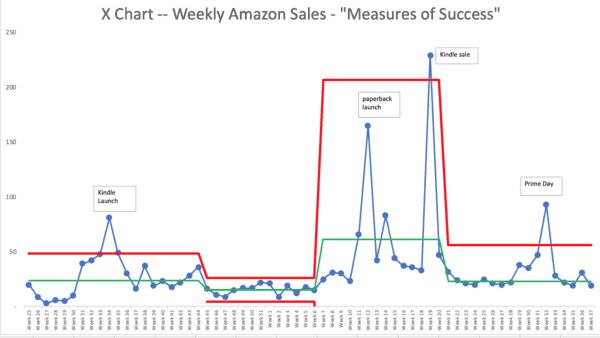
A PBC helps you understand cause-and-effect relationships in your work or your organization. There was an upward shift in sales due to paperback pre-orders and then the launch. There was a signal (spike) due to a one-day Kindle sale price. Then, there was another shift downward (inevitable post-launch decline?) and then another spike from Amazon “Prime Day” (something that Amazon did to lower the price temporarily).
Here is an updated PBC that goes through last week:
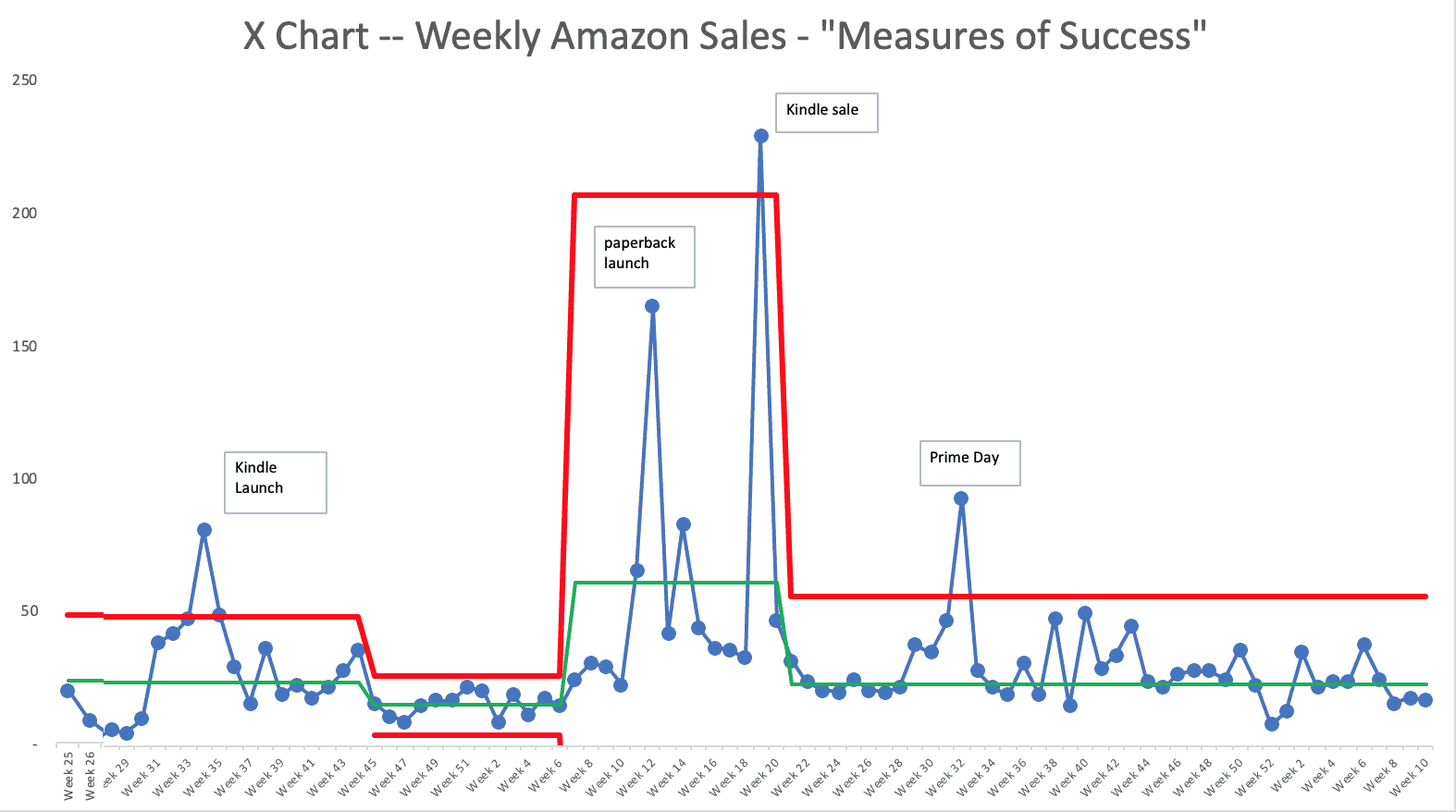
Weekly sales are still pretty much fluctuating around an average of 23 books, with an upper limit of 56. I almost had a run of 8+ points above the average late last year, but one week was 22 copies, just below the average.
So, all I've learned from the additional data points is that I can predict that I'll sell about 23 books a week… until the “system” changes for some reason.
Note, the sales numbers above do not include direct sales or bulk orders (contact me if you're interested in that, as I can give you win-win pricing on signed or unsigned copies).
The Demon of Bugs and Typos
Even though I hired an editor and 1106design had a professional proofreader, I still wasn't able to publish a defect-free book. There were typos (many of which were caught and reported by sharp-eyed readers).
I don't feel bad, as the self publisher, since the 1st edition of my Lean Hospitals (and Jeff Liker's The Toyota Way) both had typos on PAGE ONE of their initial release, as I blogged about here:
I thought the typos and defects had been eliminated… when I managed to discover TWO a few weeks back.
Can you find the typo in the Table of Contents? This is one of the typos that I caught just recently. Ugh. I hate that. Sorry.
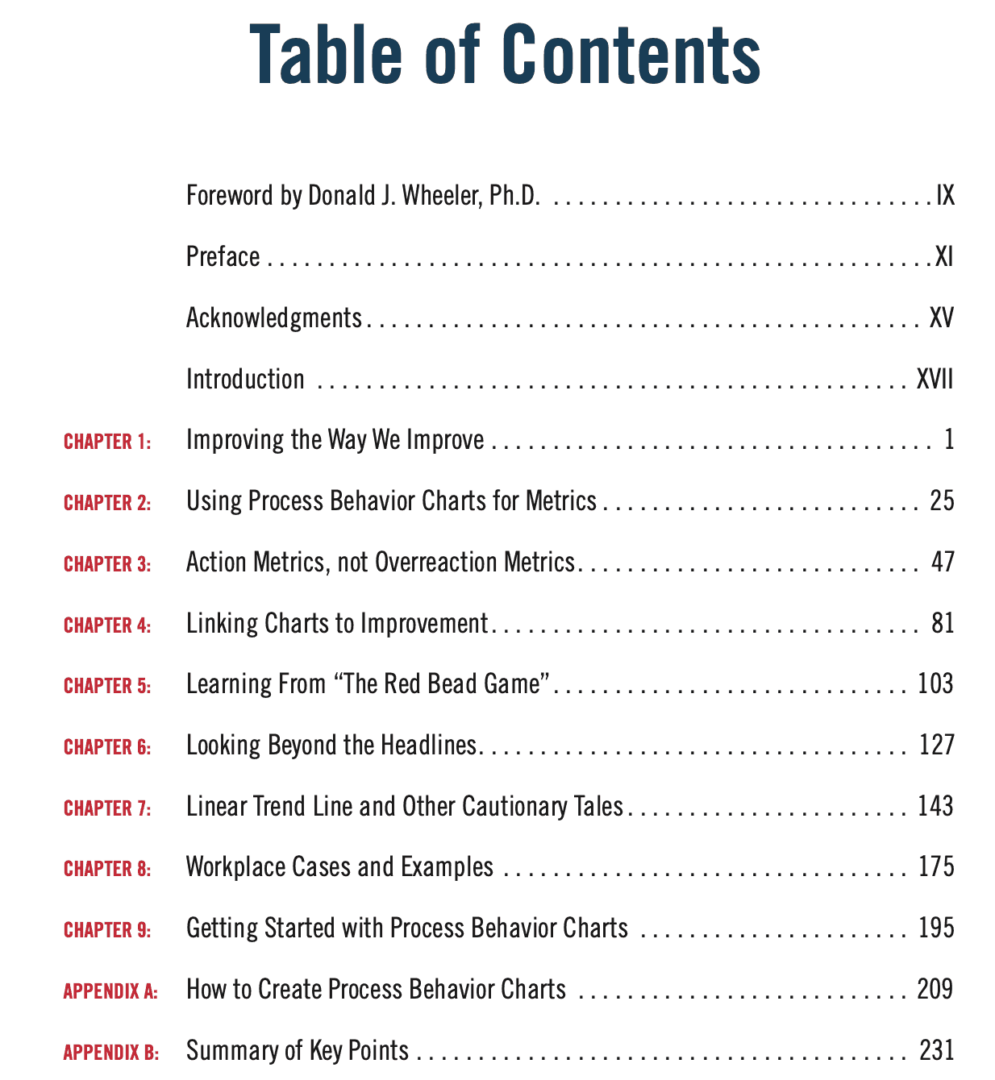
The typo was never in the eBook editions.
The one advantage of using Amazon to print (the paperbacks they sell) or IngramSpark (the hardcovers and my direct/bulk orders) is that both are print-on-demand platforms. It's not like I had a huge initial print run that could not be updated.
But, I do apologize to early readers who bought copies that weren't perfect. But, that's me being a perfectionist… as I think the books still added value to readers.
Reader Stories to Share?
I love getting questions from readers (and I often answer them here in addition to the email replies). It's amazing to hear stories of how people are using PBCs, what they're learning from them, and how they're actually reacting less, leading better, and improving more (as the subtitle of the book hypothesized).
If you have a success story to share with me about your use of Process Behavior Charts (personally, or as an organization), I'd love to hear it (click to do so). I'll mail you a signed “book plate” (a fancy name for a label that I'll autograph and then be placed in the copy of your book). That's my gift to you.
Thanks to everyone who has read the book!
Please scroll down (or click) to post a comment. Connect with me on LinkedIn.
Let’s work together to build a culture of continuous improvement and psychological safety. If you're a leader looking to create lasting change—not just projects—I help organizations:
- Engage people at all levels in sustainable improvement
- Shift from fear of mistakes to learning from them
- Apply Lean thinking in practical, people-centered ways
Interested in coaching or a keynote talk? Let’s start a conversation.









![When Was the Last Time a Leader Around You Admitted They Were Wrong? [Poll]](https://www.leanblog.org/wp-content/uploads/2025/07/Lean-Blog-Post-Cover-Image-2025-07-01T212509.843-100x75.jpg)
I love this summary of the events of the past year. Thanks so much for your transparency, and congratulations on your success!
Thanks, Cathy. And thanks so much for the coaching you’ve provided to me!!
I have been supporting and reading your Blog for years now. Thank you for sharing your wealth of knowledge and experience. I received this email today and was thinking to myself…….how did you personalize today’s topic…..today is my birthday! I had a good laugh from this.
Happy Birthday, Joe!!! :-)
Thank you, Mark!
Joe, send me a message through the “Contact” link up above and I’ll gift you an eBook (Kindle or Apple Books) or a paperback as a shared birthday gift.
Mark, as always your insight and humility are refreshing. I really enjoying knowing this was a labor of love, realizing that there was a need out there and you had a particular point to share. That is inspiring to others like you who also have a particular experience of their Lean journey to share with others.
Thanks, Dave